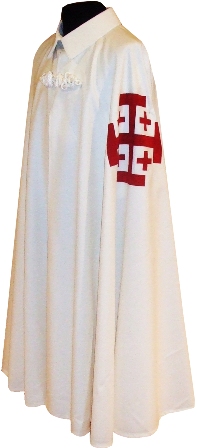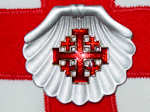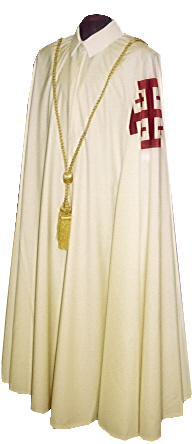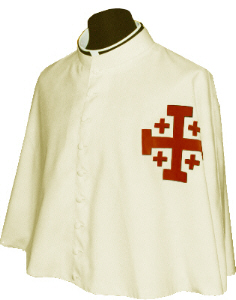 For ceremonial occasions, principally in churches or cathedrals, Knights of the Order wear a uniform comprised of a cape and beret.
In Europe, white gloves are generally worn with the ceremonial uniform,
but practice in the United States is less consistent in this regard. The cape is of
white wool, full cut, reaching to approximately half way between the knee and ankle, with a short turned over collar of white
velvet secured by a gold chain or other suitable closure.
The cape bears the cross of the Order in red wool felt on the left breast
below the shoulder. For the capes generally worn in the United States there is no other closure, and the cape hangs somewhat open from the collar closure down.
For ceremonial occasions, principally in churches or cathedrals, Knights of the Order wear a uniform comprised of a cape and beret.
In Europe, white gloves are generally worn with the ceremonial uniform,
but practice in the United States is less consistent in this regard. The cape is of
white wool, full cut, reaching to approximately half way between the knee and ankle, with a short turned over collar of white
velvet secured by a gold chain or other suitable closure.
The cape bears the cross of the Order in red wool felt on the left breast
below the shoulder. For the capes generally worn in the United States there is no other closure, and the cape hangs somewhat open from the collar closure down.
 Capes worn in Europe (see image) differ somewhat in details of the closure, but the
front generally remains open.
Capes worn in Europe (see image) differ somewhat in details of the closure, but the
front generally remains open.
There is a prescribed official full dress uniform jacket (see image below and to the left) for Knights of the Order, which is worn in some countries in Europe, but is never used in the United States.
 The beret is of black velvet and has a large, soft, draping crown. The head band is also covered with black velvet, and is raised
upward on the right front side to a height of 12 cm. On this raised portion is a patch indicating rank: for Knights, a cross on
a shield of silver braid; for Knights Commander, the shield is enclosed in a single circle of gold braid; for Knights Commander with Star, two circles of gold braid; for Knights of the Grand Cross, the shield is surrounded by a garland of olive
leaves embroidered in gold (see image).
The beret is worn with the emblem of rank on the right forehead midway between the eye and ear. The crown is given a little
tug to the opposite side to seat the beret properly upon the head.
The beret is of black velvet and has a large, soft, draping crown. The head band is also covered with black velvet, and is raised
upward on the right front side to a height of 12 cm. On this raised portion is a patch indicating rank: for Knights, a cross on
a shield of silver braid; for Knights Commander, the shield is enclosed in a single circle of gold braid; for Knights Commander with Star, two circles of gold braid; for Knights of the Grand Cross, the shield is surrounded by a garland of olive
leaves embroidered in gold (see image).
The beret is worn with the emblem of rank on the right forehead midway between the eye and ear. The crown is given a little
tug to the opposite side to seat the beret properly upon the head.
The cape and beret are worn at all ceremonies, indoors and out, when requested by the Lieutenant or Grand Prior. During Mass, the beret is normally removed when the celebrant moves to the altar at the beginning of the service and is replaced just before the final blessing. For any formal ceremonial occasion, such as the annual investiture ceremony, the cape will normally be worn over full evening dress (white tie), with full decorations on the suit. On less formal occasions the cape may be worn over a dinner jacket (black tie), or over a plain dark suit.
 Ladies of the Order wear a full-cut, ankle-length black cape which may be of velvet or satin. The cape has a short self collar,
usually worn upright. It is fastened at the throat by a tie or frog of black silk braid. The Order's cross, in scarlet wool felt
bordered with gold, is placed on the left breast of the cape below the shoulder. The cape is worn over a long black dress for
formal occasions such as investiture ceremonies, with gloves which may be long or short depending on the sleeve
length of the dress. When the cape is worn, the head is always covered with a black veil or mantilla. For
informal ceremonies the cape may be worn over a short or long dress, with dark, preferably black, shoes.
Ladies of the Order wear a full-cut, ankle-length black cape which may be of velvet or satin. The cape has a short self collar,
usually worn upright. It is fastened at the throat by a tie or frog of black silk braid. The Order's cross, in scarlet wool felt
bordered with gold, is placed on the left breast of the cape below the shoulder. The cape is worn over a long black dress for
formal occasions such as investiture ceremonies, with gloves which may be long or short depending on the sleeve
length of the dress. When the cape is worn, the head is always covered with a black veil or mantilla. For
informal ceremonies the cape may be worn over a short or long dress, with dark, preferably black, shoes.
Knights and Ladies do not wear the insignia of rank or other decorations on the outside of the cape, with the sole exception of
the pilgrim shell. Tradition holds that this most important decoration,
which indicates that the holder has made a pilgrimage to the Holy Land, may be worn on the outside of the cape, centered on the red felt cross of the Order.
The capes of the Order are religious vestments and are intended solely for use at religious ceremonies at which the Order or
individual members have been asked to participate. They may not be worn for civic or social functions without prior
permission of the Lieutenant or Grand Prior.
Tradition holds that this most important decoration,
which indicates that the holder has made a pilgrimage to the Holy Land, may be worn on the outside of the cape, centered on the red felt cross of the Order.
The capes of the Order are religious vestments and are intended solely for use at religious ceremonies at which the Order or
individual members have been asked to participate. They may not be worn for civic or social functions without prior
permission of the Lieutenant or Grand Prior.
 Lieutenants in office, or honorary Lieutenants, have the privilege of wearing the Capitular Cape. This cape is of white wool,
very full and flowing, reaching to the ground. It has a large, turned-out collar of white velvet, and is completely closed in
front. It carries the Order's cross on the left breast below the shoulder as on the Knight's cape. Worn over the Capitular Cape
is a heavy braided gold cord, with two large gold tassels in front, carrying two sliding clasps, one in front and one in back.
Lieutenants in office, or honorary Lieutenants, have the privilege of wearing the Capitular Cape. This cape is of white wool,
very full and flowing, reaching to the ground. It has a large, turned-out collar of white velvet, and is completely closed in
front. It carries the Order's cross on the left breast below the shoulder as on the Knight's cape. Worn over the Capitular Cape
is a heavy braided gold cord, with two large gold tassels in front, carrying two sliding clasps, one in front and one in back.
 The Lieutenant's beret may carry further decoration in gold braid, symbolically representing the spurs of the Order, on the
head band, in addition to the badge of rank.
The Lieutenant's beret may carry further decoration in gold braid, symbolically representing the spurs of the Order, on the
head band, in addition to the badge of rank.
Priest-Knights of the Order have the privilege of wearing the long white cape exactly as do the lay Knights. However, at the present time the mozzetta is more commonly worn. This is a short white cape, closed in the front by covered buttons, having a short standing collar. The mozzetta is worn over a cassock, and, if desired, a rochet with black cuffs, unless by another title the proper cuffs are of violet or red color. Priest-Knights may and should wear their insignia of rank, and any other proper decorations, around the neck or on the left breast. If the long white cape is worn, the decorations may be worn on the cassock.
Most of the images on this page are copyright © Barbiconi sartoria ecclesiastica 2010-2011, and are used by kind permission of the copyright holder.